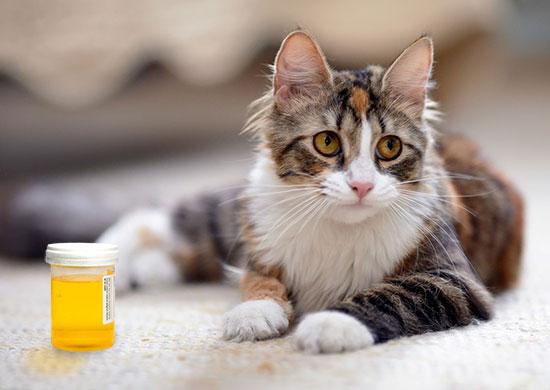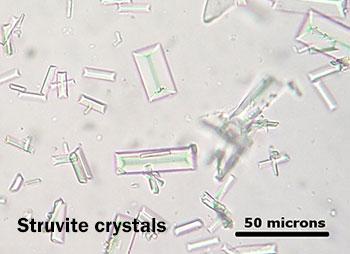This content is archived from the Feline Nutrition Foundation
Answers: What Dry Food Does to Your Cat's Pee
- Updated: Saturday, June 01, 2019 06:01 PM
- Published: Saturday, October 10, 2015 03:15 PM
- Written by Guillermo Díaz. MV
 I've been feeding my cat premium dry food all of his life, as our vet recommended. He is now 15 months old and, all of a sudden, he developed urinary blockage. After a very painful and costly procedure that included an IV catheter, blood work, anesthesia, urethral catheterization, bladder lavage and pain medication, he finally recovered and got back to normal life. The vet recommended that I now feed him a dry kibble prescription diet. I'm very confused right now because I found out that dry food can lead to urinary problems. Is this correct? Please help.
I've been feeding my cat premium dry food all of his life, as our vet recommended. He is now 15 months old and, all of a sudden, he developed urinary blockage. After a very painful and costly procedure that included an IV catheter, blood work, anesthesia, urethral catheterization, bladder lavage and pain medication, he finally recovered and got back to normal life. The vet recommended that I now feed him a dry kibble prescription diet. I'm very confused right now because I found out that dry food can lead to urinary problems. Is this correct? Please help.
These kinds of problems don't occur "all of a sudden." They brew for a long time until the physiology of the cat can't cope with the imbalance anymore and disease appears. It could be urinary blockage, cystitis, kidney disease, IBD, diabetes, hair loss, dental problems or something else. With a urinary blockage, the owner realizes her cat is straining, urinating tiny droplets or not urinating at all, licking his penis and making odd vocalizations. Before these events, the cat doesn't show any unusual behavior and appears perfectly normal.
In order to understand why cats get their tiny urethra blocked, we must do a quick review of the amazing physiology of felines. Cats evolved in extreme water-depleted environments such as the desert. This is the reason why their thirst drive is so low compared to other mammals such as dogs. So, if cats living in a water-depleted environment can't get enough water to drink, where are they supposed to get their fluids? They get it from their food. This fact about feline physiology has not changed a bit despite all of the changes of our modern society. Our cats remain the same desert dwellers and hunters as their ancestors.
Keep in mind that an average cat prey animal, such as a mouse, lizard or small bird, contains approximately 75 percent water. The average percentage of water in dry kibble is 8 percent – go check the bag. A cat consuming a dry food diet does appear to drink more water, but in the end, when moisture intake from all sources is added together – what's in their dish plus what they drink – the cat on dry food consumes much less water than one eating a natural raw cat food diet or canned food. This means that cats eating dry food are in a permanent state of some level of dehydration.
 Because of the physiological adaptations to a water-depleted environment, a cat's kidneys produce very concentrated urine, with a specific gravity usually greater than 1.040.¹ Specific gravity, denoted as SG, refers to how much solutes are held in suspension in the urine. In cats, a number below 1.020 often means the kidneys aren't working properly.² For comparison, distilled water has a SG of 1.000 and human urine is usually between 1.002 and 1.030. When eating a raw cat food diet on a regular basis, an adequate amount of water is entering into their urinary systems and flushing out the minerals and crystals in formation, keeping the bladder and the urethra healthy. I must stress though, that the finding of crystals in the urine of any species is normal. When an individual ingests an adequate amount of water for their species, the minerals and crystals are eliminated on a regular basis, preventing the buildup of stones in the urinary tract.
Because of the physiological adaptations to a water-depleted environment, a cat's kidneys produce very concentrated urine, with a specific gravity usually greater than 1.040.¹ Specific gravity, denoted as SG, refers to how much solutes are held in suspension in the urine. In cats, a number below 1.020 often means the kidneys aren't working properly.² For comparison, distilled water has a SG of 1.000 and human urine is usually between 1.002 and 1.030. When eating a raw cat food diet on a regular basis, an adequate amount of water is entering into their urinary systems and flushing out the minerals and crystals in formation, keeping the bladder and the urethra healthy. I must stress though, that the finding of crystals in the urine of any species is normal. When an individual ingests an adequate amount of water for their species, the minerals and crystals are eliminated on a regular basis, preventing the buildup of stones in the urinary tract.
When cats are given a water-depleted diet, i.e. dry kibble, the minerals from the food and metabolism build up in the bladder because of the reduced frequency of urination, producing hyper-concentrated, over-saturated urine leading finally to blockage. One can think of it this way: if you keep adding sugar to a cup of water, at some point the water can't dilute any more and it begins to precipitate out at the bottom of the cup.
I want you to realize how detrimental dry kibble is to the feline urinary system. The main compound found in the urine of blocked cats is struvite crystals. When an obligate carnivore is fed a diet high in carbohydrates, its urine becomes alkaline, which promotes the formation of struvite crystals. An alkaline urine is insulting to the mucous membrane of the bladder, generating inflammation and the production of an increased amount of mucous and blood clots. The final result is a plug in the urethra.
In order to have a healthy urinary system, all cats must maintain an acid urine. This is achieved naturally by eating raw food for cats. The benefits are: an acid pH of the urine, which promotes a healthy bladder; an adequate water intake; and the constant excretion through urination of solutes and minerals, including struvite crystals.
With all of the information available, why do veterinarians still recommend a dry type of food to "cure" a disease originated by eating a dry type of food? Because they are taught to do so at vet schools? Because of the profit margins for their practice? Because they didn't take the time to do some research? I don't know. Wouldn't it be more logical to recommend a raw cat food diet? Our companion animals would be far better fed, their urinary systems much healthier and we'd much happier, too.
Additional Reading
Raw Cat Food and Kibble Don't Mix
A Diet for Your Cat's Urinary and Kidney Health
A final thought and something I want to repeat, feline urinary tract obstruction doesn't happen because of the simple presence of crystals in the urine, it happens because of the lack of water. We must do everything we can to help cats eat a diet that allows their systems to function normally and thus avoid urinary problems.
Important: A cat with a urinary blockage needs immediate veterinary care. The situation is life-threatening if not treated.
Note: Feline Nutrition provides feline health and nutrition information as a public service. Diagnosis and treatment of specific conditions should always be in consultation with your own veterinarian. Feline Nutrition disclaims all warranties and liability related to the veterinary advice and information provided on this site.
Dr. Guillermo Díaz and family, including their four dogs (Leroy, Xica, Moza and Pepa) and six cats (Michalina, Tigger, Vladimir, Yellow, Mongo and Chirusa) moved to Buenos Aires, Argentina in July of 2017, where he expects to continue supporting different animal rescue groups, spread the benefits of raw food for cats and dogs and write articles about nutrition.
1. JD Bonagura and RW Kirk, editors, Terapéutica Veterinaria de Pequeños Animales, 12th Edition, 1997.
2. SE Aiello, editor, The Merck Veterinary Manual, 8th Edition, 1998.




